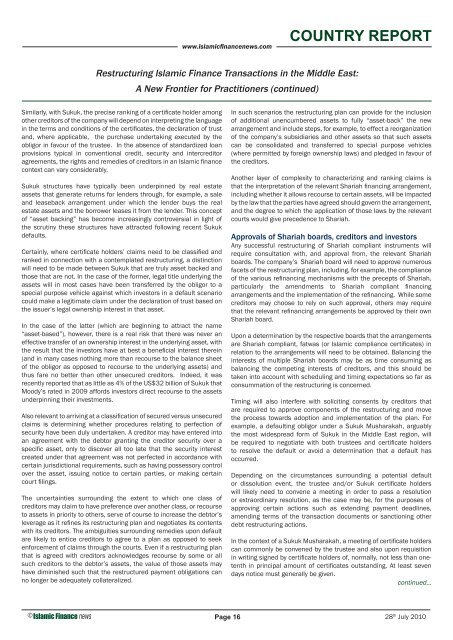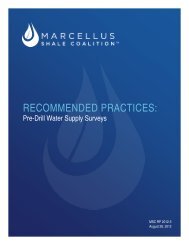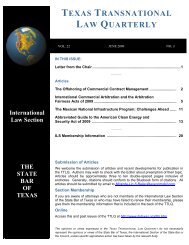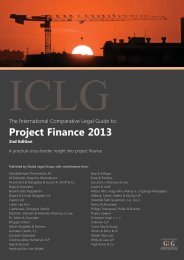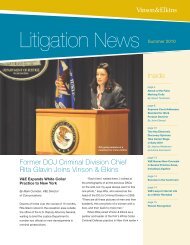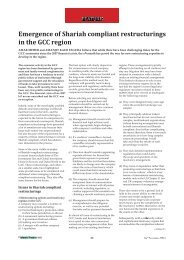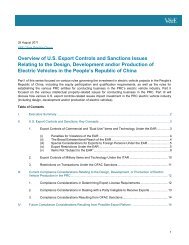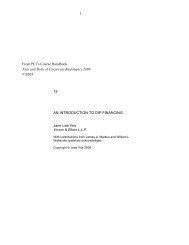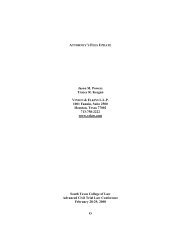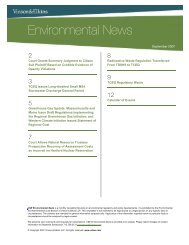Restructuring Islamic Finance Transactions in the Middle East: A ...
Restructuring Islamic Finance Transactions in the Middle East: A ...
Restructuring Islamic Finance Transactions in the Middle East: A ...
Create successful ePaper yourself
Turn your PDF publications into a flip-book with our unique Google optimized e-Paper software.
www.islamicf<strong>in</strong>ancenews.com<br />
COUNTRY REPORT<br />
<strong>Restructur<strong>in</strong>g</strong> <strong>Islamic</strong> <strong>F<strong>in</strong>ance</strong> <strong>Transactions</strong> <strong>in</strong> <strong>the</strong> <strong>Middle</strong> <strong>East</strong>:<br />
A New Frontier for Practitioners (cont<strong>in</strong>ued)<br />
Similarly, with Sukuk, <strong>the</strong> precise rank<strong>in</strong>g of a certifi cate holder among<br />
o<strong>the</strong>r creditors of <strong>the</strong> company will depend on <strong>in</strong>terpret<strong>in</strong>g <strong>the</strong> language<br />
<strong>in</strong> <strong>the</strong> terms and conditions of <strong>the</strong> certifi cates, <strong>the</strong> declaration of trust<br />
and, where applicable, <strong>the</strong> purchase undertak<strong>in</strong>g executed by <strong>the</strong><br />
obligor <strong>in</strong> favour of <strong>the</strong> trustee. In <strong>the</strong> absence of standardized loan<br />
provisions typical <strong>in</strong> conventional credit, security and <strong>in</strong>tercreditor<br />
agreements, <strong>the</strong> rights and remedies of creditors <strong>in</strong> an <strong>Islamic</strong> fi nance<br />
context can vary considerably.<br />
Sukuk structures have typically been underp<strong>in</strong>ned by real estate<br />
assets that generate returns for lenders through, for example, a sale<br />
and leaseback arrangement under which <strong>the</strong> lender buys <strong>the</strong> real<br />
estate assets and <strong>the</strong> borrower leases it from <strong>the</strong> lender. This concept<br />
of “asset back<strong>in</strong>g” has become <strong>in</strong>creas<strong>in</strong>gly controversial <strong>in</strong> light of<br />
<strong>the</strong> scrut<strong>in</strong>y <strong>the</strong>se structures have attracted follow<strong>in</strong>g recent Sukuk<br />
defaults.<br />
Certa<strong>in</strong>ly, where certifi cate holders’ claims need to be classifi ed and<br />
ranked <strong>in</strong> connection with a contemplated restructur<strong>in</strong>g, a dist<strong>in</strong>ction<br />
will need to be made between Sukuk that are truly asset backed and<br />
those that are not. In <strong>the</strong> case of <strong>the</strong> former, legal title underly<strong>in</strong>g <strong>the</strong><br />
assets will <strong>in</strong> most cases have been transferred by <strong>the</strong> obligor to a<br />
special purpose vehicle aga<strong>in</strong>st which <strong>in</strong>vestors <strong>in</strong> a default scenario<br />
could make a legitimate claim under <strong>the</strong> declaration of trust based on<br />
<strong>the</strong> issuer’s legal ownership <strong>in</strong>terest <strong>in</strong> that asset.<br />
In <strong>the</strong> case of <strong>the</strong> latter (which are beg<strong>in</strong>n<strong>in</strong>g to attract <strong>the</strong> name<br />
“asset-based”), however, <strong>the</strong>re is a real risk that <strong>the</strong>re was never an<br />
effective transfer of an ownership <strong>in</strong>terest <strong>in</strong> <strong>the</strong> underly<strong>in</strong>g asset, with<br />
<strong>the</strong> result that <strong>the</strong> <strong>in</strong>vestors have at best a benefi cial <strong>in</strong>terest <strong>the</strong>re<strong>in</strong><br />
(and <strong>in</strong> many cases noth<strong>in</strong>g more than recourse to <strong>the</strong> balance sheet<br />
of <strong>the</strong> obligor as opposed to recourse to <strong>the</strong> underly<strong>in</strong>g assets) and<br />
thus fare no better than o<strong>the</strong>r unsecured creditors. Indeed, it was<br />
recently reported that as little as 4% of <strong>the</strong> US$32 billion of Sukuk that<br />
Moody’s rated <strong>in</strong> 2009 affords <strong>in</strong>vestors direct recourse to <strong>the</strong> assets<br />
underp<strong>in</strong>n<strong>in</strong>g <strong>the</strong>ir <strong>in</strong>vestments.<br />
Also relevant to arriv<strong>in</strong>g at a classifi cation of secured versus unsecured<br />
claims is determ<strong>in</strong><strong>in</strong>g whe<strong>the</strong>r procedures relat<strong>in</strong>g to perfection of<br />
security have been duly undertaken. A creditor may have entered <strong>in</strong>to<br />
an agreement with <strong>the</strong> debtor grant<strong>in</strong>g <strong>the</strong> creditor security over a<br />
specifi c asset, only to discover all too late that <strong>the</strong> security <strong>in</strong>terest<br />
created under that agreement was not perfected <strong>in</strong> accordance with<br />
certa<strong>in</strong> jurisdictional requirements, such as hav<strong>in</strong>g possessory control<br />
over <strong>the</strong> asset, issu<strong>in</strong>g notice to certa<strong>in</strong> parties, or mak<strong>in</strong>g certa<strong>in</strong><br />
court fi l<strong>in</strong>gs.<br />
The uncerta<strong>in</strong>ties surround<strong>in</strong>g <strong>the</strong> extent to which one class of<br />
creditors may claim to have preference over ano<strong>the</strong>r class, or recourse<br />
to assets <strong>in</strong> priority to o<strong>the</strong>rs, serve of course to <strong>in</strong>crease <strong>the</strong> debtor’s<br />
leverage as it refi nes its restructur<strong>in</strong>g plan and negotiates its contents<br />
with its creditors. The ambiguities surround<strong>in</strong>g remedies upon default<br />
are likely to entice creditors to agree to a plan as opposed to seek<br />
enforcement of claims through <strong>the</strong> courts. Even if a restructur<strong>in</strong>g plan<br />
that is agreed with creditors acknowledges recourse by some or all<br />
such creditors to <strong>the</strong> debtor’s assets, <strong>the</strong> value of those assets may<br />
have dim<strong>in</strong>ished such that <strong>the</strong> restructured payment obligations can<br />
no longer be adequately collateralized.<br />
In such scenarios <strong>the</strong> restructur<strong>in</strong>g plan can provide for <strong>the</strong> <strong>in</strong>clusion<br />
of additional unencumbered assets to fully “asset-back” <strong>the</strong> new<br />
arrangement and <strong>in</strong>clude steps, for example, to effect a reorganization<br />
of <strong>the</strong> company’s subsidiaries and o<strong>the</strong>r assets so that such assets<br />
can be consolidated and transferred to special purpose vehicles<br />
(where permitted by foreign ownership laws) and pledged <strong>in</strong> favour of<br />
<strong>the</strong> creditors.<br />
Ano<strong>the</strong>r layer of complexity to characteriz<strong>in</strong>g and rank<strong>in</strong>g claims is<br />
that <strong>the</strong> <strong>in</strong>terpretation of <strong>the</strong> relevant Shariah fi nanc<strong>in</strong>g arrangement,<br />
<strong>in</strong>clud<strong>in</strong>g whe<strong>the</strong>r it allows recourse to certa<strong>in</strong> assets, will be impacted<br />
by <strong>the</strong> law that <strong>the</strong> parties have agreed should govern <strong>the</strong> arrangement,<br />
and <strong>the</strong> degree to which <strong>the</strong> application of those laws by <strong>the</strong> relevant<br />
courts would give precedence to Shariah.<br />
Approvals of Shariah boards, creditors and <strong>in</strong>vestors<br />
Any successful restructur<strong>in</strong>g of Shariah compliant <strong>in</strong>struments will<br />
require consultation with, and approval from, <strong>the</strong> relevant Shariah<br />
boards. The company’s Shariah board will need to approve numerous<br />
facets of <strong>the</strong> restructur<strong>in</strong>g plan, <strong>in</strong>clud<strong>in</strong>g, for example, <strong>the</strong> compliance<br />
of <strong>the</strong> various refi nanc<strong>in</strong>g mechanisms with <strong>the</strong> precepts of Shariah,<br />
particularly <strong>the</strong> amendments to Shariah compliant fi nanc<strong>in</strong>g<br />
arrangements and <strong>the</strong> implementation of <strong>the</strong> refi nanc<strong>in</strong>g. While some<br />
creditors may choose to rely on such approval, o<strong>the</strong>rs may require<br />
that <strong>the</strong> relevant refi nanc<strong>in</strong>g arrangements be approved by <strong>the</strong>ir own<br />
Shariah board.<br />
Upon a determ<strong>in</strong>ation by <strong>the</strong> respective boards that <strong>the</strong> arrangements<br />
are Shariah compliant, fatwas (or <strong>Islamic</strong> compliance certifi cates) <strong>in</strong><br />
relation to <strong>the</strong> arrangements will need to be obta<strong>in</strong>ed. Balanc<strong>in</strong>g <strong>the</strong><br />
<strong>in</strong>terests of multiple Shariah boards may be as time consum<strong>in</strong>g as<br />
balanc<strong>in</strong>g <strong>the</strong> compet<strong>in</strong>g <strong>in</strong>terests of creditors, and this should be<br />
taken <strong>in</strong>to account with schedul<strong>in</strong>g and tim<strong>in</strong>g expectations so far as<br />
consummation of <strong>the</strong> restructur<strong>in</strong>g is concerned.<br />
Tim<strong>in</strong>g will also <strong>in</strong>terfere with solicit<strong>in</strong>g consents by creditors that<br />
are required to approve components of <strong>the</strong> restructur<strong>in</strong>g and move<br />
<strong>the</strong> process towards adoption and implementation of <strong>the</strong> plan. For<br />
example, a default<strong>in</strong>g obligor under a Sukuk Musharakah, arguably<br />
<strong>the</strong> most widespread form of Sukuk <strong>in</strong> <strong>the</strong> <strong>Middle</strong> <strong>East</strong> region, will<br />
be required to negotiate with both trustees and certifi cate holders<br />
to resolve <strong>the</strong> default or avoid a determ<strong>in</strong>ation that a default has<br />
occurred.<br />
Depend<strong>in</strong>g on <strong>the</strong> circumstances surround<strong>in</strong>g a potential default<br />
or dissolution event, <strong>the</strong> trustee and/or Sukuk certifi cate holders<br />
will likely need to convene a meet<strong>in</strong>g <strong>in</strong> order to pass a resolution<br />
or extraord<strong>in</strong>ary resolution, as <strong>the</strong> case may be, for <strong>the</strong> purposes of<br />
approv<strong>in</strong>g certa<strong>in</strong> actions such as extend<strong>in</strong>g payment deadl<strong>in</strong>es,<br />
amend<strong>in</strong>g terms of <strong>the</strong> transaction documents or sanction<strong>in</strong>g o<strong>the</strong>r<br />
debt restructur<strong>in</strong>g actions.<br />
In <strong>the</strong> context of a Sukuk Musharakah, a meet<strong>in</strong>g of certifi cate holders<br />
can commonly be convened by <strong>the</strong> trustee and also upon requisition<br />
<strong>in</strong> writ<strong>in</strong>g signed by certifi cate holders of, normally, not less than onetenth<br />
<strong>in</strong> pr<strong>in</strong>cipal amount of certifi cates outstand<strong>in</strong>g. At least seven<br />
days notice must generally be given.<br />
cont<strong>in</strong>ued...<br />
© Page 16<br />
28 th July 2010


